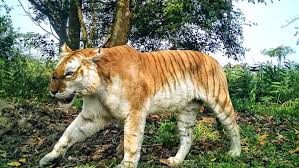
India’s only Golden Tiger, Kazi 106F emerged as the social media sensation right from the moment its picture. The tigers present in Kaziranga habitat are totally different from the remainder of the world as in territorial behavioural sample and this makes a detailed research on them much more fascinating and difficult.
Daily Current Affairs Quiz 2020
Key-Points
Kazi 106 F, the tigress, resides in world heritage Kaziranga National Park of Assam. It is also known as ‘Tabby tiger’ or ‘Strawberry tiger’.
The skin of tigers is orange-yellow with black stripes and whitish abdominal region.
The yellowish background is controlled by a set of ‘agouti genes’ and their alleles and the black colour stripes are controlled by ‘tabby genes’ and their alleles. Suppression of any of these genes may lead to colour variation in tiger.
Agouti genes interacts with the pigment cells to produce yellow to red or brown to black expression. This interaction is responsible for making distinct light and dark bands in the hairs of animals such as the agouti here same is happening in our tigress – Kazi 106 F.
Kaziranga National Park
Kaziranga National Park is a national park in the Golaghat, Karbi Anglong and Nagaon districts of the state of Assam, India.
The sanctuary, which hosts two-thirds of the world’s great one-horned rhinoceroses, is a World Heritage Site.
Kaziranga is a vast expanse of tall elephant grass, marshland, and dense tropical moist broadleaf forests, criss-crossed by four major rivers, including the Brahmaputra, and the park includes numerous small bodies of water.
Kaziranga has been the theme of several books, songs, and documentaries.
The park celebrated its centennial in 2005 after its establishment in 1905 as a reserve forest.





